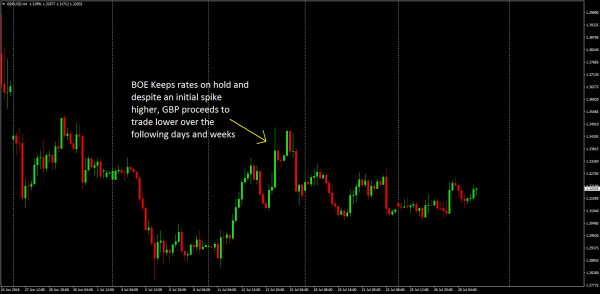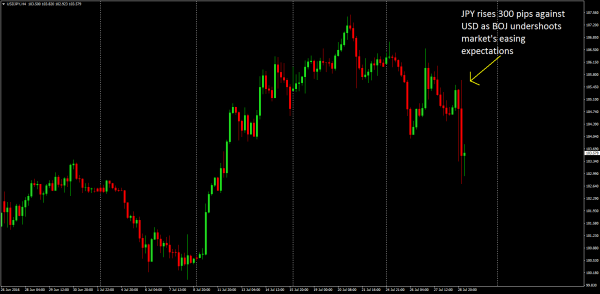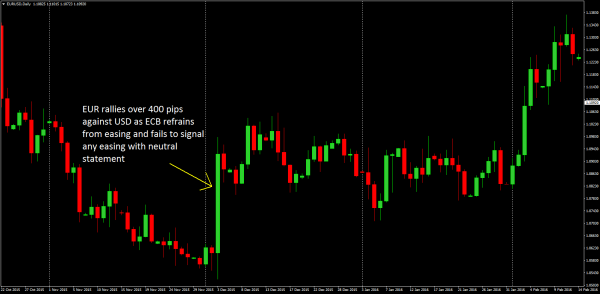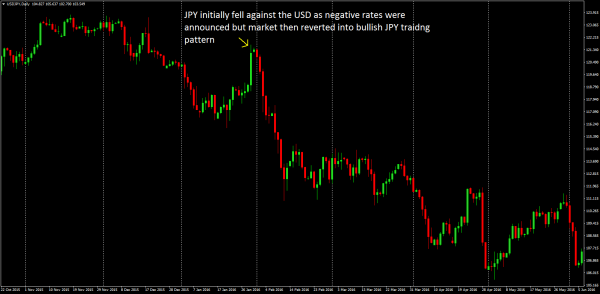Among the endless stream of economic events hitting wires each month there are a few key events that tend to dominate the action and among those central bank rate decisions are arguably the most important. However, trading these events can be tricky for new traders who don’t yet properly understand the nuances that distinguish highly volatile, market moving events from the vanilla non-events.
Furthermore, the actual market response to central bank rate decisions can sometimes be confusing with rate cuts resulting in stronger currencies and unchanged decisions resulting in aggressive rallies.
To help improve your trading of these key events it is vital to establish a proper understanding of the key factors that determine market response. Let’s, first of all, consider what these events entail and the traditional impact they are perceived to have.
Central Bank Rate Decisions
Each month, the central banks of the world hold their rate setting meetings where they decide whether to keep rates unchanged, lower them or raise them. These meetings are crucial in determining investor sentiment for a given currency and affecting fundamental flows. The conventional wisdom around these events suggests that:
- If a central bank raises rates, typically the currency of that economy will rise as the higher rates attract foreign investment.
- Conversely, a decreases in rates tends to lead to a depreciation in the currency of that economy as foreign investors seek yield elsewhere.
- Rates kept on hold can either be bullish or bearish depending on the tone of the accompanying statement and whether or not the central bank was expected to move rates.
The Role Of Market Expectations In The Impact of Rate Decisions
This brings us on to an important point: the role of investor expectations in market volatility around rate decisions.
- If markets are expecting a central bank to lower rates and the central bank decides to keep rates on hold, this is seen as a bullish driver and the currency tends to rise.
- However, if the central bank was expected to raise rates and they instead keep rates on hold, then this is seen as a bearish driver, and typically rates will fall.
However, the rate decision alone is not always the most important aspect of these meetings and the accompanying monetary policy statement and/or press conference following the events are keenly scrutinised by traders as they provide further colour on how the central bank views the current economic climate and their outlook for the future, e.g., how they might act in the future based on their forecasts.
- If A central bank keeps rates on hold but strikes a very Dovish tone in the meeting highlighting a bleak economic outlook and outlining their intentions to ease in future, then a currency might still trade lower even if rates are kept unchanged.
The above example shows GBPUSD around the July BOE meeting which markets expected was going to see the bank announce a rate cut at their July in response to Britain’s decision to leave the EU. However, the BOE opted not to cut rates at that meeting though did strike a very Dovish tone and gave a clearly signal of their intention and likely need to cut rates at the August meeting. In light of the Dovish statement accompanying the meeting, GBP traded lower over the following days.
- However, if a central bank keeps rates on hold but strikes a very Hawkish tone in the meeting, sounding very upbeat about the economy and offering guidance on the likely need to raise rates in the near term, then despite the unchanged decision, the currency could still rise.
Again, rate decisions are not the only measures that can be employed at these meeting and the central bank in recent years have used these events to announce monetary stimulus programs known as quantitative easing either alongside rate moves or in lieu of. Expectations around QE announcements are just as important as expectations around rate decisions.
- QE announced by surprise or QE of a larger amount than expected can have a significant impact on markets.
- Similarly, if markets are expecting a certain level of QE to be announced and are disappointed, the reaction can be severe.
A good example is the July BOJ. A huge amount of speculation had been built up ahead of the meeting with traders expecting the bank to adopt unconventional methods in a bid to stimulate the economy and combat deflation but at the very least to announce a further rate cut and an increase in QE from Y3.3trln to Y7trln. However, the BOJ refrained from adopting any unconventional methods and even fell short of market consensus by keeping rates on hold and instead raising QE to just Y6trln. Markets responded aggressively by buying JPY.
Impact of Central Bank Credibility on Market Expectations
Central bank credibility is a driving force behind market expectations. If a central bank is seen to consistent in following up their words with actions, then verbal intervention can be an effective tool whereby the central bank is able to war against higher currency rates lest they should need to intervened. However, if a central bank loses their credibility and appears to be making “empty threats” then verbal intervention ceases to be a tool they can use.
In December 2015 the ECB were widely expected to announce further easing measures or at the very least give a clear signal of their intent to ease further as well as a nod to the sort of policy adjustments markets could expect. However, despite a lot of pre-emptive rhetoric on behalf of the ECB and highly elevated market expectations, the ECB decided to keep rates on hold and struck a very neutral tone in their meeting downplaying the likelihood of easing in the near term. The market responded to this with a 400+ pip rally in EURUSD.
Initial Reaction Versus Sustained Reaction
Another key aspect of market volatility around rate decisions is that we need to distinguish between an initial “reaction” move and then the sustained fundamental impact on the market. Very often positioning adjustment in response to these events, such as profit taking, can lead to a short-term spike in currency but once these initial flows are absorbed the currency will then revert into a fundamental trading pattern.
A great example of this is the Bank of Japan’s historic announcement in January this year that for the first time in Japanese history they were adopting negative rates. Whilst this unprecedented move initially yielded a near 3% selloff in JPY against the US Dollar., the move was immediately reversed the next day, and the Japanese Yen proceeded to rally against the US Dollar by more than 18% five months later.
Textbook economic theory suggests that negative rates should translate into a lower currency value as foreign investors seek yield elsewhere. However, the Yen’s status as a traditional safe-haven currency means that during times of economic uncertainty investors sell foreign assets and repatriate their capital into Yen. This dynamic alongside a growing skepticism as to the effectiveness of traditional easing measures in Japan led to a stronger JPY. Indeed, referencing the CFTC positioning data shows that shortly after the Japanese Govt introduced negative rates JPY positioning flipped to net long (more buyers than sellers) for the first time in four years.
Summary
It is quite clear that market expectations are an extremely important factor in whether or not a rate decision has a market-moving impact or not. The actual rate decision itself is only relevant within the context of market expectations and hence, a rate increase might not always translate into a higher currency, and a rate decrease might not always translate into a lower currency. Similarly, a decision to keep policy on hold might actually result in bigger moves depending on the level of expectation in the market.
Hopefully, by now you can see that central bank rate decisions are complex, important events that offer a lot of opportunities if properly understood. To get an idea of the key expectations ahead of each central bank meeting Orbex prepares central bank previews which can help you to understand what industry analysts are looking for and the sort of outcomes to expect.
















